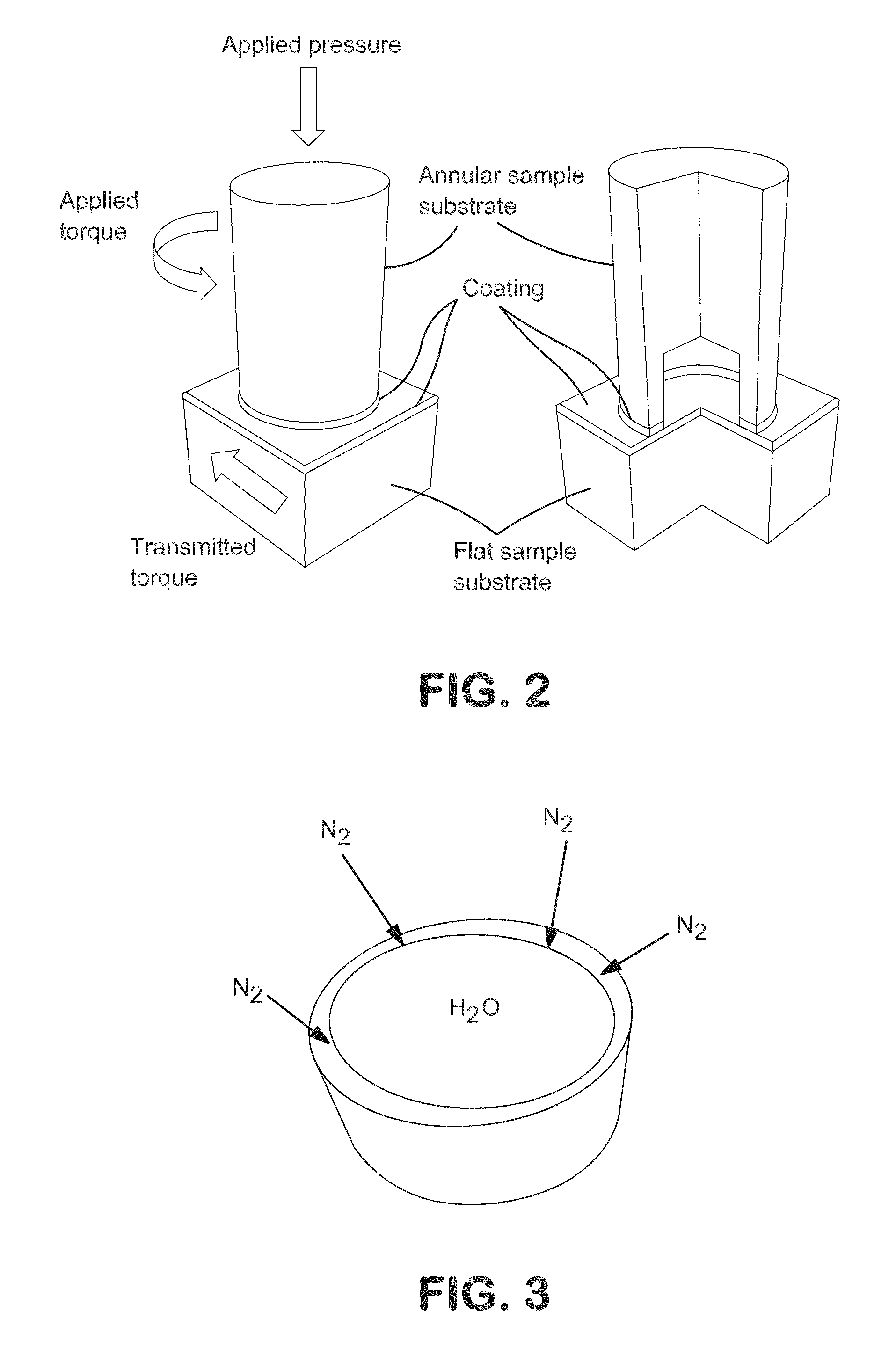Fluid tight low friction coating systems for dynamically engaging load bearing surfaces
a load bearing surface, fluid-tight technology, applied in the direction of coatings, mechanical equipment, superimposed coating processes, etc., can solve the problems of high frictional force, impeded or interrupted fluid flow, and increased frictional force, so as to reduce the friction coefficient
- Summary
- Abstract
- Description
- Claims
- Application Information
AI Technical Summary
Benefits of technology
Problems solved by technology
Method used
Image
Examples
example 1
Leak Test for Present Invention—FIG. 6
[0062]A powder blend of a tungsten carbide-cobalt chromium material and a metallic cobalt alloy was employed to produce a coating using a Super D-Gun® coating process. The coating was applied to the test sample having a diameter of approximately 2.8 inches and a thickness of approximately 1.5 inches. A low friction layer of DLC was applied onto the underlying coating. The DLC was applied by PaCVD.
[0063]A high pressure leak test was conducted. No bubbles were observed along the periphery of the tested sample as shown in FIG. 6 at an applied pressure of 10,000 psi after 10 minutes of testing. The lack of bubbles at high pressure was an indication of the ability of the coating with DLC and with sealant to prevent leakage.
example 2
Friction Test for Present Invention at 10,000 Psi—FIG. 9 Orange Line
[0064]The frictional behavior of the inventive thermal spray coating system was evaluated using the twist compression test at 10,000 psi contact pressure with no lubrication. The coating to be tested was a Super D-Gun® coating derived from a powder blend of a tungsten carbide-cobalt chromium material and a metallic cobalt alloy. The Super D-Gun® coating was deposited onto the annular sample substrate. The other coating was a HVOF WC—CoCr coating which was deposited onto the flat sample substrate. A low friction layer of DLC was applied onto the underlying Super D-Gun® coating. The DLC was applied by the Pa CVD process.
[0065]When a pressure of 10,000 psi was generated, the annular sample was rotated. Torque transmission between a rotating annular cylinder and a flat sample was measured, and the coefficient of friction was calculated from the ratio of transmitted torque to applied pressure.
[0066]FIG. 9 shows the resul...
example 3
Friction Test for Present Invention at 30,000 Psi—FIG. 10 Orange Line
[0067]The frictional behavior of an inventive thermal spray coating system was evaluated using the twist compression test at 30,000 psi contact pressure with grease. The coating to be tested was a Super D-Gun® coating derived from a powder blend of a tungsten carbide-cobalt chromium material and a metallic cobalt alloy. The Super D-Gun® coating was deposited onto the annular sample substrate. The other coating was a HVOF WC—CoCr coating, which was deposited onto the flat sample substrate. A low friction layer of DLC was applied onto the underlying coating Super D-Gun® coating. The DLC was applied by a PaCVD process.
[0068]When a pressure of 30,000 psi was generated, the annular sample was rotated. Torque transmission between a rotating annular cylinder and a flat sample was measured, and the coefficient of friction was calculated from the ratio of transmitted torque to applied pressure.
[0069]FIG. 10 shows the result...
PUM
| Property | Measurement | Unit |
|---|---|---|
| thickness | aaaaa | aaaaa |
| thickness | aaaaa | aaaaa |
| pressures | aaaaa | aaaaa |
Abstract
Description
Claims
Application Information
 Login to View More
Login to View More - R&D
- Intellectual Property
- Life Sciences
- Materials
- Tech Scout
- Unparalleled Data Quality
- Higher Quality Content
- 60% Fewer Hallucinations
Browse by: Latest US Patents, China's latest patents, Technical Efficacy Thesaurus, Application Domain, Technology Topic, Popular Technical Reports.
© 2025 PatSnap. All rights reserved.Legal|Privacy policy|Modern Slavery Act Transparency Statement|Sitemap|About US| Contact US: help@patsnap.com



